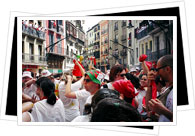While Pamplona's most famous festival, Los Sanfermines, is dedicated to him, few people outside of Pamplona actually know of Christian martyr San Fermín.
Living around the turn of the 3rd century (272 - 303 AD), Fermín was born in the city of Pompaelo (modern day Pamplona) back when the city was part of the extensive Roman Empire. Fermín was not born a Christian; instead, he was born into a pagan Roman family, including a high-ranking father of senatorial status. Fermín first learned of Christianity from French bishop San Saturnino (Saint Saturnin) who was passing through the town in his mission to spread Christianity.
 Fermín felt instantly inspired and traveled to France shortly after to study the religion and become a missionary himself. He found himself in Amiens, France where he built the town's first church - now the largest surviving Romanesque church in France - and eventually became a bishop himself.
Fermín felt instantly inspired and traveled to France shortly after to study the religion and become a missionary himself. He found himself in Amiens, France where he built the town's first church - now the largest surviving Romanesque church in France - and eventually became a bishop himself.
Unfortunately, Christianity was still met by a great deal of resistence throughout Europe and when Fermín ran into a group of local powers unaccepting of Christianity, he was promptly imprisoned. He was ordered to renounce his faith and, when he refused, he was beheaded and buried.
Centuries later in 1186, some of his remains were brought back to Pamplona, an event that made the city's largely forgotten son hugely popular. Five years later, the townspeople inaugurated an annual event to honor him. How the celebration morphed into a week of non-stop partying and dashing down narrow streets ahead of a pack of agitated bulls is anyone's guess!